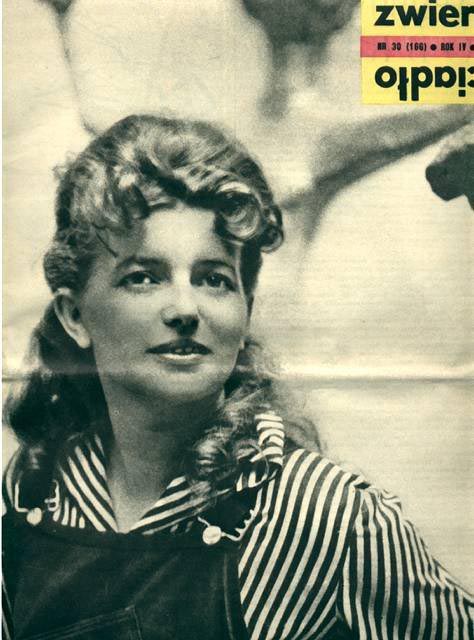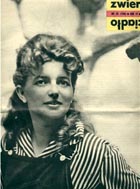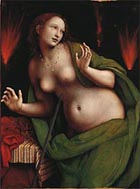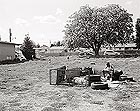
translated and summarized by: Liz Wollner-Grandville,
English summary December 26 - January 14: English summary December 26 - January 14
Zacheta Narodowa Galeria Sztuki: Alina Slesinska
Feminist futurism
Only in the last couple of years has Poland finally started to account for the works of those artists, whose legacy has been forgotten after the political turnaround. The urgent need to organize solo exhibits on behalf of individual avant-garde artists was obvious. Thanks to Polish museums directors and reviewers, artists such as Oskar Hansen, Tadeusz Kantor and Jerzy Kujawski found their way back into the art history books of Poland. Especially the recently published treatises are of high value.
In one of these solo exhibits Alina Slesinska’s works are shown. She was one of the most talented female sculptors in the 60s – famous in the West and nearly unknown in Poland. Today she is nearly forgotten, mainly because her works disappeared.
Exhibits in Paris, London, and New York were part of her life.
She organized projects in Ghana and Brasil featuring sculptures and is one of the very few artists who were mentioned in “La sculpture de XX siecle. Dictionnaire de la sculpture moderne” by the Swiss critic Michel Seuphor. During the socialist era in Poland her sculptures were admired in Museums in Paris, London, Vienna and Washington. The Brazilian architect Oskar Niemeyer worked together with Slesinska in his “Brasilia” project. This is when she created the sculpture “motherhood”. She also constructed a monument in honour of President Kwame Nkrumah in Ghana, which was destroyed after he was overthrown in 1965.
The exhibit in Warsaw shows some of her architectural designs, all of which are characterized by truly revolutionary features. A futuristic city designed on two levels is remarkable, especially if one considers the period in which Slesinska created this draft. Numerous sketches display architectural discipline paired with incredible imagination. This is what surrealist architecture could have resembled. Was Alina Slesinska a visionary? An artist who inscribed herself into feminist art history? These propositions are rather daring. Slesinska created a vast number of drafts, all of which had strong visionary features and she was a talented sculptor, but she could most certainly not a rebellious feminist. On the other hand: if you leave the Zacheta Gallery, pass by the Josef Pilsudski monument to one of the main streets, the “Aleje Jerozolismskie, you will observe a new kind of architecture in Warsaw, that has a remarkable resemblance with Alina Slesinka’s designs of the 20s. Obviously many avenues are left open in these futuristic experiments.
Zacheta Narodowa Galeria Sztuki
00-916 Warszawa, pl. Malachowskiego 3, until 24. 02. 08
http://www.zacheta.art.pl
Liechtenstein Museum: The Borromeo Collection and the Cohen Collection
Old collection meets new collection
Collectors have one thing in common: the passion to own beautiful objects, to admire them and to share this enthusiasm with others. Two collections are currently being shown at the Liechtenstein Museum that divaricate from one another. One of them is in the possession of a family since the 15th century, the other originated only 14 years ago, and is continuously being enhanced.
The collection of the Principi Borromeo Arese focuses on Renaissance art works and autographs of Renaissance artists. The works have been collected for generations. For the past 70 years these objects have been stowed away in a vault on the Borromean Islands (Isola Bella) on Lago Maggiore and have not been exhibited since. In the future the family plans to exhibit these works on the Borromean Islands. The display in Vienna, where 30 objects are being shown, was prepared in collaboration with the Museo Poldi Pezzoli in Milan. This was made possible through the recently formed “Private Art Collections”.
The Cohen Collection from New York is showcased in the Neoclassical Library at the Palais Liechtenstein. The “Twinight Collection” is in the possession of the 50-year-old American businessman Richard Baron Cohen. For the past 14 years he has been collecting the most important antique neoclassical porcelain offered in the world. He keeps his most favourite pieces in his bedroom. Cohen focuses on collecting porcelain created by famous porcelain manufacturers in Vienna, Berlin, and Sèvres between 1800 and 1840. In the meantime his unrivalled collection includes 2.500 outstanding pieces. The collection now on display in Vienna was originally conceptualized for Berlin and enriched with objects from the German capital. In Vienna these objects have been “substituted” by pieces from the Liechtenstein Collection. Together with the comprehensive text that has been published for this exhibit, the Cohen collection has been “ennobled in the old Europe”.
Liechtenstein Museum
1090 Vienna, Fürstengasse 1, until 11. 02. 08
http://www.liechtensteinmuseum.at
Deutsche Guggenheim Berlin: Jeff Wall – Exposure
Wallpaper
The Deutsche Guggenheim (considered by some as the advertising department of the Deutsche Bank) celebrates its 10th birthday with an exhibit of four new photographs by the Canadian artist Jeff Wall. Wall’s work is displayed for the first time in the Deutsche Guggenheim and the choosing this artist must be considered as proof of true sensitivity: Wall’s work is highly appreciated by both the public as well as by critics. The audience adores his large, colourful photographs, which seem to glow like advertisements in light boxes and also have a similar irresistible effect. The critics value him, because his sophisticated compositions as well as his cryptic art historical references challenge their ingenuity; they want to reward him with worthy and masterful interpretations. And last but not least collectors rate him highly, mainly because he limited his works to only 150 photos over a time span of 30 years, thereby making each piece a valuable rarity.
Jeff Wall’s show at the Deutsche Guggenheim displays the four new photographs in conjunction with five earlier pieces. The majority of his works deal with the lives of the underprivileged. Boys playing with toy guns, a group of unemployed workers hanging around, and a bleak garage sale – all of these photos do not form a subversive type of commitment, showing the devastating effects of the post-industrial, globalised economy and simultaneously accusing the profiteers. These injustices give Wall the pretence to take photos and to transpose these tragedies into an acceptable form. The fourth work in this group of new photos is a documentary image, which does not include figures. Wall succeeds in giving a cold storage facility the impression of being a cathedral in which even the sky threatens to collapse - a type of transubstantiation that seems to be a miracle.
For the next anniversary at the Deutsche Guggenheim we should wish for someone like Hans Haacke. He has already proven that he can lend his ear to the worldly sins of the Deutsche Bank. Absolution would not easily be granted by someone like him.
Deutsche Guggenheim Berlin
10177 Berlin, Unter den Linden 13 – 15, until 20. 01. 08
http://www.deutsche-guggenheim-berlin.de
Augarten Contemporary: Markus Schinwald
Schinwald’s world
Markus Schinwald has been invited to the Augarten on many occasions, but this time the entire Belvedere Dependence is at his disposal. The exhibit is a linear continuation of his repertoire. He tries to “decline” different types of media in an ironical but seemingly well-behaved manner. A curtain delivers the prelude - followed, in the order of appearance, by paintings, sculptures, film projections, and object art. All in all: an abstract installation. The exhibition doesn’t offer any surprises, however the constructive systems of white beams, which cross the rooms vertically and horizontally, interrupt Schinwald’s “patina aesthetics”. The beams are both an obstacle, serve as a seat, or are simply meant to be a kind of “free intervention”. But they definitely aim at being a synthesis of the arts.
But you will also see the perverseness and metamorphosis that Schinwald is well-known for: people painted with excrescences that are probably meant to turn their maimed inner to the outside; sculptures made of table legs on a veneered pedestal intended to mock classical academic sculptures; a handicapped puppet on a motor-driven swing high above the heads of the visitors. In the middle of the exhibit, which was designed by Günther Domenig, the film “Ten in Love” (2006) shows bland figures involved in nonsensical occupations and tense interpersonal actions. A penetrating soundtrack, giving the tenor for the entire exhibit: an unnerving sound and a man’s voice reciting a portentous text, which attempts to be poetic (“the air is cold, but the earth is colder”).
Schinwald does not allow anything to go beyond Schinwald. Projects cannot be identified; moods are imposed upon us, and then we are stuck with them.
The publication of this exhibition should exclusively be recommended to fans. It only contains 92 short articles, each with one illustration. 92 terms that aim at defining Schinwald’s “artistic cosmos” (press release). Seems to be an easy way to argue how important an oeuvre is, without having to write one word about its quality. But maybe the organizers assume that they are discharged from this task due to Schinwald’s sweeping market- and exhibition success.
Augarten Contemporary / Belvedere
1020 Vienna, Scherzergasse 1a, until 27.01.08
http://www.atelier-augarten.at
Mehr Texte von translated and summarized by: Liz Wollner-Grandville
English summary December 26 - January 14
14.01 - 14.07.2008
Deutsche Guggenheim Berlin
10117 Berlin, Unter den Linden 13 - 15
Tel: 0049 (0) 30 20 20 93 0, Fax: 0049 (0) 30 20 20 93 20
Email: berlin.guggenheim@db.com
http://www.deutsche-guggenheim-berlin.de
Liechtenstein Museum (geschlossen)
1090 Wien, Fürstengasse 1
Tel: +43 / 1 / 319 57 67 - 252, Fax: +43 / 1 / 319 57 67 - 255
Email: info@liechtensteinmuseum.at
http://www.liechtensteinmuseum.at
Öffnungszeiten: Freitag bis Dienstag 10.00–17.00 Uhr, Mittwoch und Donnerstag geschlossen
Zacheta Narodowa Galeria Sztuki
00-916 Warszawa, pl. Malachowskiego 3
Tel: +48 22 827 58 54, Fax: +48 22 827 78 86
http://www.zacheta.art.pl
Augarten Contemporary
1020 Wien, Scherzergasse 1a
https://www.erstestiftung.org/de/events/kyjiw-bienniale-2023/
Öffnungszeiten: Mi - So 12-18 h
14.01 - 14.07.2008
Deutsche Guggenheim Berlin
10117 Berlin, Unter den Linden 13 - 15
Tel: 0049 (0) 30 20 20 93 0, Fax: 0049 (0) 30 20 20 93 20
Email: berlin.guggenheim@db.com
http://www.deutsche-guggenheim-berlin.de
Liechtenstein Museum (geschlossen)
1090 Wien, Fürstengasse 1
Tel: +43 / 1 / 319 57 67 - 252, Fax: +43 / 1 / 319 57 67 - 255
Email: info@liechtensteinmuseum.at
http://www.liechtensteinmuseum.at
Öffnungszeiten: Freitag bis Dienstag 10.00–17.00 Uhr, Mittwoch und Donnerstag geschlossen
Zacheta Narodowa Galeria Sztuki
00-916 Warszawa, pl. Malachowskiego 3
Tel: +48 22 827 58 54, Fax: +48 22 827 78 86
http://www.zacheta.art.pl
Augarten Contemporary
1020 Wien, Scherzergasse 1a
https://www.erstestiftung.org/de/events/kyjiw-bienniale-2023/
Öffnungszeiten: Mi - So 12-18 h


 Teilen
Teilen




